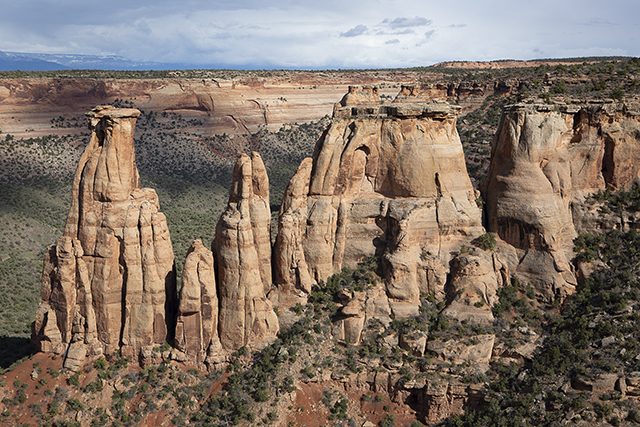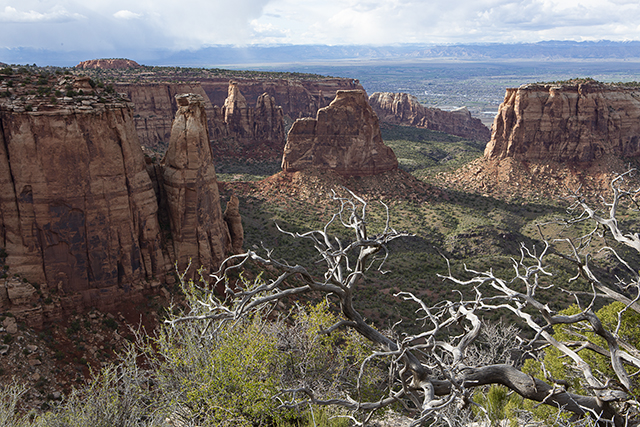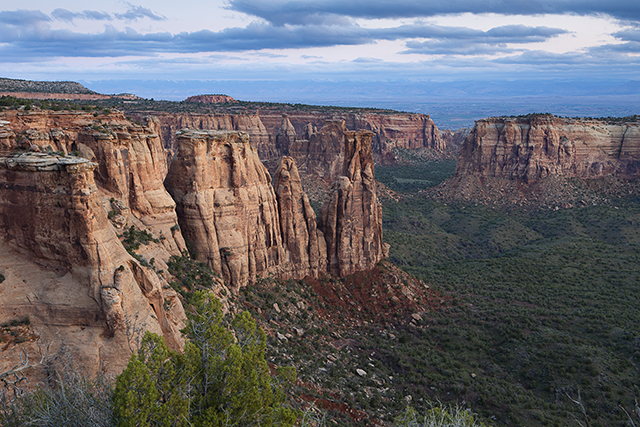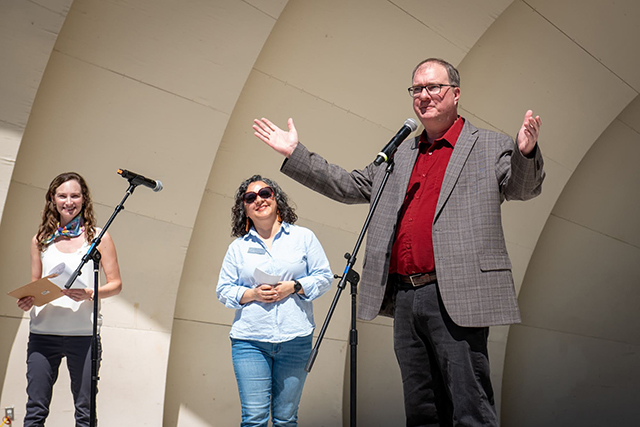Cosmic Landscapes of the Colorado Plateau
19 Jun 2023
Geological marvels beckon the adventurous to Colorado National Monument
By Matt Maenpaa » Photos Steven McBride

It is quite difficult to drive anywhere in Colorado without encountering stunning vistas and remarkable landscapes. In fact, you don’t have to drive far afield from Boulder to find the snow-capped peaks of the Rocky Mountains—if all you want to do is look at them, the drive from Nederland to Lyons along CO 72 has you covered.
One must venture beyond the bounds of the backyard, though, to find places remarkable and otherworldly. A few hundred miles west of Boulder, red-rock spires and deep-cut canyons carved by time call adventurers to the striking Colorado National Monument.
Set on 31 square miles of high-altitude desert south of Grand Junction, the national monument contains multitudes. Along with the monument’s main thoroughfare, Rim Rock Drive, more than 50 total miles of hiking trails wind through canyons and scrub, home to flora and fauna not often found east of the Rockies, including collared lizards and rare blooms.
The “Heart of the World”
John Otto found the canyonlands south of Grand Junction so remarkable he took up residence there in 1906 and began a quest to lobby the federal government and its burgeoning national parks program to have the land added to the roster.
“I came here last year and found these canyons, and they feel like the heart of the world to me,” Otto once said. “I’m going to stay and build trails and promote this place because it should be a national park.”
Otto would start building trails by hand, all the while inviting Presidents Roosevelt and then Taft to come visit the land. Eventually, in 1911, Taft would declare the land a national monument and Otto its first superintendent.
According to the monument’s supervisory park ranger, Rachel Berger, the monument earned its name after much deliberation with Otto, the local chamber of commerce and then Colorado Representative Edward Taylor. Otto had suggested naming it “Smith National Park,” thinking that the common surname would draw more visitors. Otto wrote at the time that “every Smith in the United States would feel that he had a personal interest in the new National Park”
After considering more than a few options, Taylor’s wife suggested the simple Colorado National Monument for its designation. The name wasn’t in use anywhere else at the time, so the debate was swiftly settled.

A Natural Nexus
The land Otto found so enthralling is a culmination of unique geological elements found in Colorado and neighboring regions. The park’s sandstone structures share qualities with those found in Utah’s Arches National Park, while the hard rock layers at the bottom of the canyons can be found in the nearby Black Canyon of the Gunnison.
“There are around 1.5 billion years of geological history to explore and strange and beautiful rock formations to view,” Berger said. “Rim Rock Drive is a 23-mile-long scenic drive that gives many perspectives on the canyons, the Redlands fault and various rock formations.”
Although the Colorado River contributed to shaping the Grand Valley on its westward journey, the canyons owe more to erosion from Pinyon Mesa and the larger Uncompahgre Plateau. The monoliths, fins and towers were further shaped and split by uplift from fault lines, contributing to their otherworldly appearance.
A unique geography also lends itself to an array of flora and fauna. Twisted pinyon trees and blooming cacti grow alongside snakeweed and sagebrush. In the spring, baby desert bighorn sheep play in the rocks, while summer brings out the swift collared lizards.

Otherworldly Vistas
Although the monument hasn’t developed the fame of places like Arches or Devil’s Tower in Wyoming, the almost-alien landscape of the Colorado National Monument has drawn its own appeal. In the 1980s, a stage of the international Coors Classic cycling race was held in the monument, with the route along Rim Rock Drive earning it the nickname “Tour of the Moon.”
Denver resident Chanel Berumen, who grew up near Grand Junction, recalled picnics and stargazing with her grandfather, Jack Gilmore. Gilmore was a park ranger at the monument, she explained, who would share all the mysteries and natural wonders of the monument.
“The Monument is like Mars on Earth, with these sprawling red rocks that seem to go on forever,” Berumen said. “Getting to grow up near this extraterrestrial background has led to some of the most remarkable sunsets I’ve ever seen.”
Be Prepared
Visitors looking to explore the monument for themselves would do well to come prepared. The climate is dry and temperatures can reach well over 100 degrees in the summer, Berger warned. There is no water available in the monument, so adventurers should come with their own, along with snacks and plenty of sunscreen. Dogs are also prohibited in the monument, though nearby McInnis Canyons National Recreation Area welcomes them.
“The monument is open all year round, and people can take advantage of cooler weather in the fall, winter and spring to go explore,” Berger said.
Summer hikers should get a very early start on the day to avoid the afternoon sun, but the area can also be explored via Rim Rock Drive without leaving the car.
“The road is 23 miles long and has overlooks, which makes it possible to have a great visit without needing to hike,” Berger added. “That can be very nice when it’s 105 degrees outside.”
Explorers can find more information to help them plan and prepare at the monument visitor center in Fruita, along with gas, food and water.












